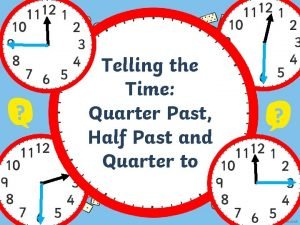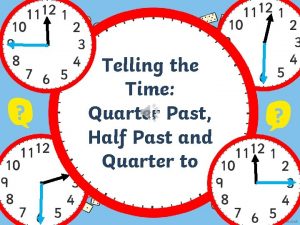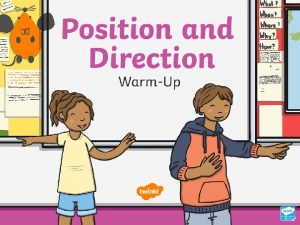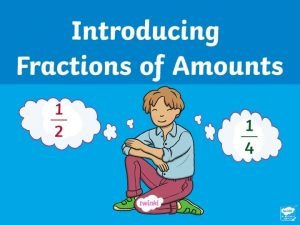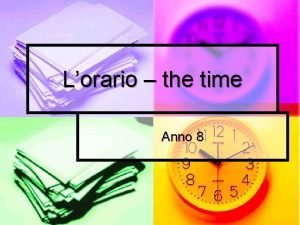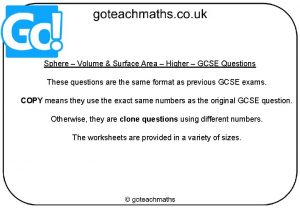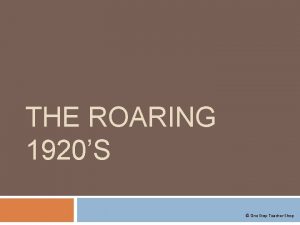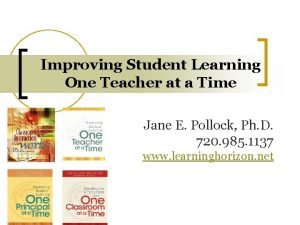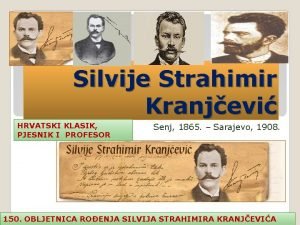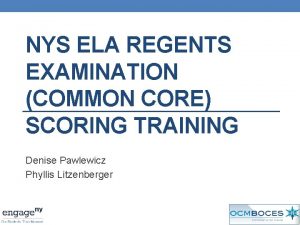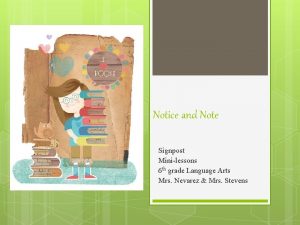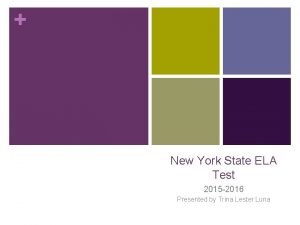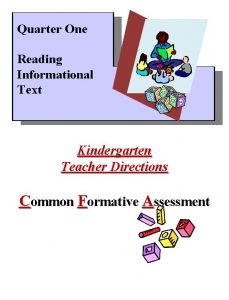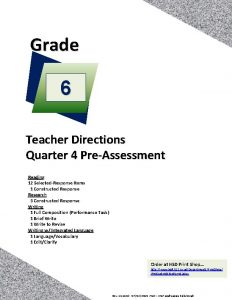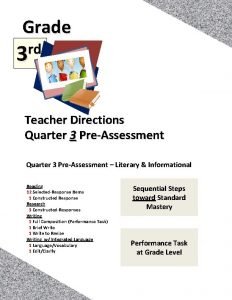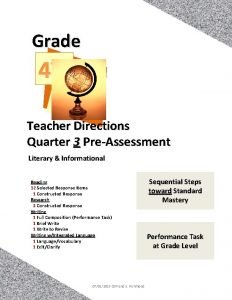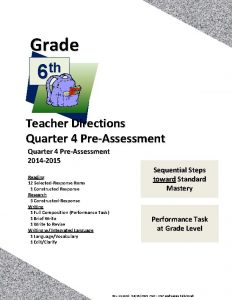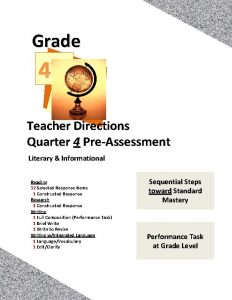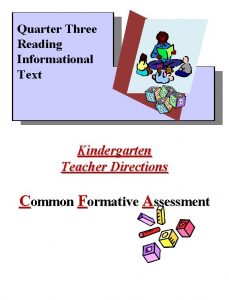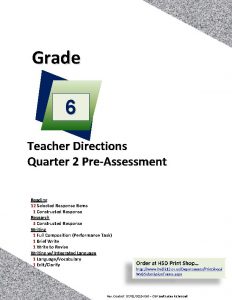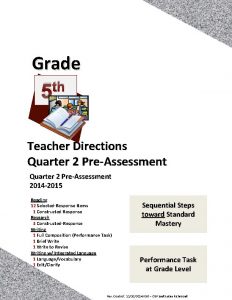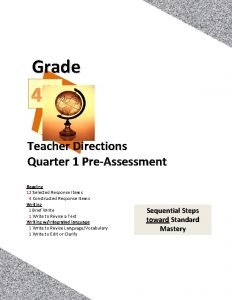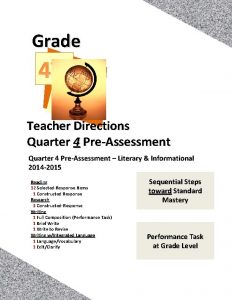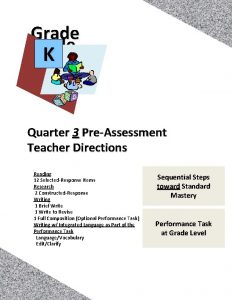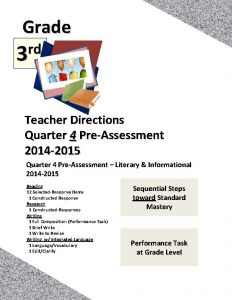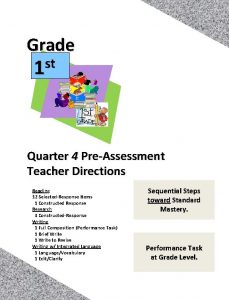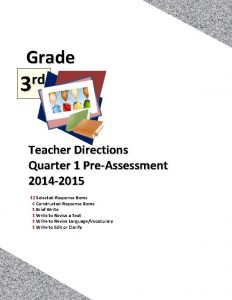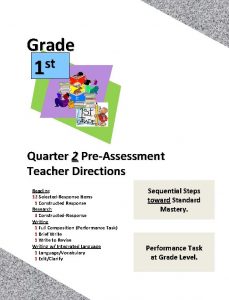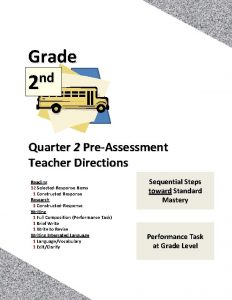th 4 Quarter One ELA CFAssessment Teacher Directions






























- Slides: 30

th 4 Quarter One ELA CFAssessment Teacher Directions Reading: Literature Targets 1 Standards Key Details RL. 4. 1 RL. 4. 3 (can move to DOK 3) 2 Central Ideas RL. 4. 2 DOK 1 -2 2 Reading: Informational Targets Standards 8 Key Details RI. 4. 1 9 Central Ideas RI. 4. 2 RI. 4. 3 (can move to DOK 3) DOK 1 -2 2 Note: There may be more standards per target. Writing standards assessed in this assessment are circled. Writing Targets Standards DOK 6 a Brief Opinion Write W. 4. 1 a, W. 4. 1 b, W. 4. 1 c, W. 4. 1 d, W. 4. 8 3 6 b Write-Revise Opinion W. 4. 1 a, W. 4. 1 b, W. 4. 1 c, W. 4. 1 d, W. 4. 8 2 8 Language-Vocabulary Use L. 4. 3 a, L. 4. 6 1 -2 9 Edit and Clarify L. 4. 2 c 1 -2

Quarter One English Language Arts Common Formative Assessments Team Members and Writers This assessment was developed working backwards by identifying the deep understanding of the two passages. Key Ideas were identified to support constructed responses and key details were aligned with the selected response questions. All questions support students’ background knowledge of a central insight or message. Shannon Berkey Raquel Lemus. Garcia Sandy Maines Berta Lule Tammy Cole Janet Stintson Gina Mc. Lain Judy Ramer Nicole Thoen Patricia Gallardo Lisa Carnes Teresa Portinga Jami Rider Linda Benson Dori Sipe Laycee Kinsman Sonja Grabel Christina Arosco Teresa Portinga Irma Ramirez Thank you to all of those who reviewed and edited and a special appreciation to Vicki Daniels and her amazing editing skills. All elementary ELA assessments were reviewed and revised in June of 2015 by the following amazing and dedicated HSD K-6 th grade teachers. Deborah Alvarado Lincoln Street Sonja Grabel Patterson Gina Mc. Lain TOSA Linda Benson West Union Megan Harding Orenco Teresa Portinga Patterson Anne Berg Eastwood Renae Iversen TOSA Judy Ramer Consultant Aliceson Brandt Eastwood Ginger Jay Witch Hazel Sara Retzlaff Mc. Kinney Sharon Carlson Minter Bridge Ko Kagawa Minter Bridge Jami Rider Free Orchards Deborah Deplanche Patterson Jamie Lentz Mooberry Kelly Rooke Free Orchard Alicia Glasscock Imlay Sandra Maines Quatama Angela Walsh Witch Hazel 2

Order at HSD Print Shop… http: //www. hsd. k 12. or. us/Departments/Print. Shop/ Web. Submission. Forms. aspx About this Assessment SBAC assessments are made up of four item types: Selected Response, Constructed Response, Technology‐Enhanced, and Performance Task. HSD Quarter One Assessments consist of 20 questions with Writing items now included in the assessment scores. There are no Performance Tasks (PT) in quarter 1 assessments. The ELA Performance Tasks focus on reading, writing, speaking and listening, and research claims. They measure capacities such as depth of understanding, interpretive and analytical ability, basic recall, synthesis, and research. There are NO Technology-enhanced Items/Tasks (TE) Note: It is highly recommended that students have experiences with the following types of tasks from various on-line instructional practice sites, as they are not on the HSD Elementary Assessments: reordering text, selecting and changing text, selecting text, and selecting from drop-down menus. An Important Note: If students are not reading at grade level and can’t read the text, please read the stories to the students and ask the questions. Please note the level of differentiation a student needed. Scaffold over the year until students are reading and doing more of the assessment independently as they are able. Note: The reading constructed response questions do NOT assess writing proficiency and should not be Note: scored as such. These constructed responses are evidence of reading comprehension. OPTIONAL SCORING SHEET AVAILABLE. . (Assessment Class Summary Sheet) • When students have finished the assessment you may enter the total number of correct selected and constructed responses on the Assessment Class Summary Sheet if desired. • Return the scored test booklets to the students. Students record their responses as correct or incorrect. • The last page in the student booklet is a student reflection page. This last page activity is invaluable for understanding how to differentiate student instructional needs. 07/04/2015 OSP‐S. Richmond

Determining Grade Level Text Grade level text is determined by using a combination of both the CCSS new quantitative ranges and qualitative measures. Example: If the grade equivalent for a text is 6. 8 and has a lexile of 970, quantitative data shows that placement should be between grades 4 and 8. Common Core Band Flesch-Kincaid® The Lexile Framework® 2 nd - 3 rd 1. 98 - 5. 34 420 - 820 4 th - 5 rd 4. 51 - 7. 73 740 - 1010 6 th – 8 th 6. 51 - 10. 34 925 - 1185 9 th – 10 th 8. 32 - 12. 12 10. 50 - 1335 11 th - CCR 10. 34 - 14. 20 11. 85 - 1385 Four qualitative measures can be looked at from the lower grade band of grade 4 to the higher grade band of grade 8 to determine a grade level readability. Rate your text from easiest to most difficult between bands. 4 Qualitative Factors Beginning of lower (band) grade End of lower (band) grade Beginning of higher (band) to mid End of higher (band) grade Purpose/Meaning Structure Language Clarity Language Overall Placement The combination of the quantitative ranges and qualitative measures for this particular text shows that grade 6 would be the best readability level for this To see more details about each of the qualitative measures please go to slide 6 of: text. http: //www. corestandards. org/assets/Appendix_A. pdf 07/04/2015 OSP‐S. Richmond Not suited to band

A Note about constructed responses: Constructed response answers are not written “in stone. ” There is no perfect way a student should respond. Look for the general intent of the prompt and student response and follow the rubric below as much as possible. Use your best judgment. Unlike DOK-1 questions where there is one right and wrong answer, constructed responses are more difficult to assess. Overall consistency of intent based on most of your student responses can guide you. Quarter 1 CFA Constructed Response Answer Key Standard RL. 4. 2: 2 Point Short Reading Constructed Response Rubric Question #7 (prompt): Locate key details and explain how they support theme of “Lost on Ellis Island”. Teacher Language and Scoring Notes: The theme of this passage is that you never know what interesting things you will discover when you keep your mind open. In the passage, Emily is grumpy about being at yet another museum. “They’d done nothing but walk, and visit more museums than she could count” (These are specific details). She wants to be at the Statue of Liberty as opposed to Ellis Island. After she separated from her family, a machine caught her attention in the Family Records Room and “it made something stir inside Emily’s brain”. She allowed herself to become excited as she typed in her grandfather’s name. “Emily read everything she could about the Dombrowski family, and then started searching for other people” (this is sufficient evidence or details that supports the prompt). The student gives a proficient response by providing evidence of how details support theme of “Lost on Ellis Island, ” and uses specific examples from the text as well as details about (supports) each example. 2 1 0 “When I read Lost on Ellis Island, I saw that in the beginning Emily was not happy to visit so many museums. She wanted to go to the Statue of Liberty. But then she started looking up information about her Grandfather and got excited that she found him. She realized she could have fun at museums. ” The student gives a partial response by providing some evidence of key details that support theme of “Lost on Ellis Island, ” and some specific examples that support the text. Emily didn’t want to be at Ellis Island, but she ended up having fun, because she learned something about her Grandfather. The student provides no evidence of key details that support theme. Ellis Island looks huge. Standard RL. 4. 2 Determine a theme of a story, drama, or poem from details in the text; summarize the text. 07/04/2015 OSP‐S. Richmond

A Note about constructed responses: Constructed response answers are not written “in stone. ” There is no perfect way a student should respond. Look for the general intent of the prompt and student response and follow the rubric below as much as possible. Use your best judgment. Unlike DOK-1 questions where there is one right and wrong answer, constructed responses are more difficult to assess. Overall consistency of intent based on most of your student responses can guide you. Quarter 1 CFA Constructed Response Answer Key Standard RL. 4. 3: 3 Point Reading Constructed Response Rubric Question #8 (prompt): Describe Emily’s actions at Ellis Island that led to her enjoying the museum. Use specific details from the text to support your answer. Teacher Language and Scoring Notes: Emily went from little enthusiasm for being at the museum to enjoying her visit there, so much so she got lost from her family (sufficient evidence). With a grumpy attitude, her father let her go on her own. With this, “Emily felt her chest loosen slightly…Now that she was by herself, Ellis Island didn’t feel so bad. ” (details to support the prompt). “The sign said “Family Records, ” and it made something stir inside Emily’s brain, ” remembering her grandfather’s stories of immigrating to the U. S. as a child. “She began navigating” and found exciting information about her grandfather. From there she became fascinated with searching for other people. “She was so engrossed that she forgot the time. ” In the end, she realized it was nice to get to Ellis Island. The student gives a proficient response by providing evidence of how Emily’s actions led to her enjoying the museum and uses specific details from the text to support each example. 3 2 1 0 In the story, Lost on Ellis Island, Emily actions showed that she liked going to Ellis Island. I know this because she was grumpy at first but in the end she said that it was nice. She also felt better being away from her family and exploring on her own. She was excited about what she found about her grandpa and others. The student gives a proficient response by providing some evidence of how Emily’s actions led to her enjoying the museum and some specific details from the text to support each example. In the story, Emily enjoyed Ellis Island. She went off on her own in the museum. She went to the Family Records Room and found out information about her grandfather. The student gives a minimal response by providing limited evidence of how Emily’s actions led to her enjoying the museum with few specific details from the text. Emily had fun at Ellis Island. She learned a lot about her grandpa. The student provides no evidence of how Emily’s actions led to her enjoying the museum. Emily is a girl in the story about Ellis Island. Standard RL. 4. 3 Describe in depth a character, setting, or event in a story or drama, drawing on specific details in the text (e. g. , a character's thoughts, words, or actions). 07/04/2015 OSP‐S. Richmond

A Note about constructed responses: Constructed response answers are not written “in stone. ” There is no perfect way a student should respond. Look for the general intent of the prompt and student response and follow the rubric below as much as possible. Use your best judgment. Unlike DOK-1 questions where there is one right and wrong answer, constructed responses are more difficult to assess. Overall consistency of intent based on most of your student responses can guide you. Quarter 1 CFA Constructed Response Answer Key Standard RI. 4. 2: 2 Point Short Reading Constructed Response Rubric Questions #15 (Prompt): What is the main idea of the text, Ellis Island: The Hunt for Alois Hanousek? Use key details from the text to support your answer. Teacher Language and Scoring Notes: Sufficient Evidence: The main idea of the text is how the two sisters found information about their great‐grandfather Alois Hanousek. Specific indications could include details that support the main idea in a sequential style. Details could include (1) the sisters went to Ellis Island, (2) their great‐grandfather probably went through Ellis Island, (3) Ellis Island kept records of immigrants and (4) they found records about Alois Hanousek. Full Support are the examples given around or about each detail. The first detail ( the sisters went to Ellis Island) is supported by the example that the sisters took a ferry from Battery Park on the southern tip of Manhattan and passed the Statue of Liberty to get to Ellis Island. The second details (their grandfather probably went through Ellis Island) is supported by the example that most immigrants arrived there from 1892 to 1954. The third detail (Ellis Island kept immigrant records) is supported by the example that the sisters arrived at the research center and began looking on a computer. The fourth detail (finding records of Alois) is supported by the example that “ My great‐grandfather’s name. It was written as “Canousek. It had been spelled wrong at Ellis Island, ” and the information they learned about their great‐grandfather. The student gives a proficient response by providing evidence of the main idea and uses specific examples from the text as well as details about (supports) each example. 2 1 0 In the text about Alois Hanousek, the main idea is that two sisters wanted to learn more about their great‐grandfather and how they did learn more. The sisters went to Ellis Island on a Ferry. They passed the Statue of Liberty. When they arrived they were amazed at how big it was. They also read that most immigrants had passed through there from 1892 to 1954. The girls went to the research center where immigrant records were kept. They found out that their great‐grandfather did go through Ellis Island but his name was spelled Canousek instead of Hanousek. Their journey was successful. The student gives a partial response by providing some evidence of the main idea and some specific examples that reference the text as well as details about each example. Two sisters wanted to learn about their great‐grandfather because no one really knew much about him. They planned a trip to Ellis Island to learn more and they did! They learned about his age and health. The student provides no evidence about the main idea and no relevant information or examples from the text. I think the Statue of Liberty was really neat for the immigrants to see! Standard RI. 4. 2 Determine the main idea of a text and explain how it is supported by key details; summarize the text. 07/04/2015 OSP‐S. Richmond 7

A Note about constructed responses: Constructed response answers are not written “in stone. ” There is no perfect way a student should respond. Look for the general intent of the prompt and student response and follow the rubric below as much as possible. Use your best judgment. Unlike DOK-1 questions where there is one right and wrong answer, constructed responses are more difficult to assess. Overall consistency of intent based on most of your student responses can guide you. Quarter 1 CFA Constructed Response Answer Key Standard RI. 4. 3: 3 Point Reading Constructed Response Rubric Question #16 (prompt): What clues helped the narrator imagine what it might have been like to be an immigrant? Support your answer with details or examples from the text Ellis Island: The Hunt for Alois Hanousek. Teacher Language and Scoring Notes: Students will need to infer. Sufficient Evidence would include all details and/or examples provided in the student response that supports what the sister (the narrator) learned about being an immigrant that are explicitly stated in the text (Ellis Island: The Hunt for Alois Hanousek). Specific Inferences could include (1) inferring how immigrants felt when they first saw the Statue of Liberty, (2) inferring how immigrants felt in the photographs at the museum, (3) inferring how family treasures made it easier to be in a new country and (4) inferring how immigrants felt if they were split up. Full Support of the inferences could be the examples of (1) “I imagined how my great‐grandfather must have felt when he first saw the majestic lady with the golden torch, ” (2) “The museum had photographs of immigrants everywhere. Some looked weary from their long voyage. Others looked excited. Still others looked sad, ” (3) “As we walked around the building, you could see all the things people brought with them. There were also religious items and family treasures, such as musical instruments. I imagined that these things made it easier to be a stranger in a strange, new land, ” and (4) “Some families were split up, and had to say goodbye to each other in tears. ” Other examples are acceptable if they are adequately supported by details about what the sisters could learn about being an immigrant. The student gives a proficient response by providing evidence of how the narrator learned what it was like to be an immigrant by going to Ellis Island uses specific examples from the text as well as details about (supports) each example. 3 2 1 0 The sisters went to Ellis Island to learn about their great‐grandfather but one of them also learned about what it would have been like to be an immigrant arriving to Ellis Island. She imagined what an immigrant went through because they are at the very place immigrants came to. Almost like going back in time! They passed the statue of liberty just like the immigrants did and she imagines how their great‐grandfather felt when he saw it. At the museum she could imagine how the immigrants felt by looking at the photographs and what they must have went through because of the sad faces. She could imagine how the treasures they brought with them to America helped them come to a new land. The student gives a partial response by providing some evidence of how the narrator learned what it was like to be an immigrant by going to Ellis Island some specific examples from the text as well as details about (supports) each example. Two sisters went to Ellis Island to learn more about their great‐grandfather. One of them started thinking about how it must have been to be an immigrant. She was Rebekah’s sister and is telling the story but they don’t mention her name. She saw pictures of sad immigrants and knew they must have felt sad and scared. The student gives a minimal response but provides limited evidence of how the narrator learned what it was like to be an immigrant by going to Ellis Island limited examples or details from the text. One girl wanted to know about her great‐grandfather so she went to Ellis Island learned about other immigrants too. The student provides no evidence, details or supports for examples in response to the prompt. Immigrants were people who came to America a long time ago. Standard RI. 4. 3 Explain events, procedures, ideas, or concepts in a historical, scientific, or technical text, including what happened and why, based on specific information in the text. 07/04/2015 OSP‐S. Richmond 8

Brief Write Rubric Answer Key Writing Standard W. 4. 1 b Opinion Writing - Target 6 a Question # 17 (Prompt): Write a brief paragraph supporting the opinion that it is important to research about your ancestors and how to do so. Use details and examples from both passages as sources to support this opinion. Scoring Notes: • Essential elements of a complete interpretation of the prompt would be a definite supportive opinion that it is important to research about your ancestors. • Aspects of the task and sufficient relevant evidence to support development of the paragraph would include details and examples from both passages as sources to support the opinion that it is important to research about your ancestors. • Focused and organized, the student’s response consistently addresses the purpose, audience, and task. • Sentences are of varied length and structure. The student response gives a definite supportive opinion statement supporting that it is important to research about your ancestors. The statement is supported by sufficient details and examples from both passages. 3 It is important to research and learn about your ancestors. Sometimes we hear stories about grandparents or other family members who came to America. The family history may be lost or no one really knows much about the family member who immigrated. Sometimes you can’t find out much about the ancestor because names were changed to be American names, so history records can be hard to find. If you do find family records you can learn about your ancestors age, health, where they came from, why they left and maybe more information about other family members. If grandparents have passed away there is no one left to share the family history. It’s nice to know where they lived because it’s like a part of you that you can pass on to your children. The student response gives a definite supportive opinion statement supporting that it is important to research about your ancestors. The statement is supported by some details and examples from both passages. 2 If you don’t know who your ancestors were you might be able to find out. It can be important because it is family history you can share with your brothers or sisters or even parents or other relatives. Everyone likes to know where their family came from and why. You can go to Ellis Island to find out about some ancestors if they came to Ellis Island. They have history records about millions of people. The student response gives a vague supportive opinion statement supporting that it is important to research about your ancestors. The statement is not supported by sufficient details and examples from both passages. 1 0 Ancestors are people in your family that lived a long time ago or are really old today. Some families don’t know who their ancestors were. You should know because that is your family. I think I know who my ancestors are or at least some of them. I look into some old family albums and find out a lot of information, but not all of it. I still need to learn more. The student response does not give a definite supportive opinion statement. I have two grandmas and my dad said I also have a great grandpa who lives somewhere near New York. I’m not sure but I think so. He is an ancestor. 07/04/2015 OSP‐S. Richmond

Quarter 1 CFA Selected Response Answer Key Question 1 Which room on Ellis Island did Emily find interesting? RL. 4. 1 C Question 2 Why did Emily leave Ellis Island more interested than when she came? RL. 4. 1 B Question 3 Which response best summarizes Emily’s experience on Ellis Island? RL. 4. 2 D Question 4 What is theme of Lost on Ellis Island? RL. 4. 2 A Question 5 Which statement supports Emily’s feeling that “there was such a thing as too much family Question 5 vacation? ” RL. 4. 3 C Question 6 How does the author’s use of dialogue lead us to believe Emily’s family is frustrated with Question 6 her? RL. 4. 3 B Question 7 Literary Constructed Response RL. 4. 2 Question 8 Literary Constructed Response RL. 4. 3 Question 9 Which detail best summarizes why the author had a blank space on his family tree? RI. 4. 1 9 D Question 10 Which information best supports the reason why the author said it looks like they would Question 10 be making another trip to the Czech Republic? RI. 4. 1 D Question 11 Why did the author most likely say, “I imagined that these things made it easier to be a Question 11 stranger in a strange, new land”? RI. 4. 2 C Question 12 Which clues help to identify why some of the immigrants in the photographs were sad? Question 12 RI. 4. 2 D Question 13 Why was it important that the author of Ellis Island: The Hunt for Alois Hanousek searched other names when looking for great‐grandfather’s last name? RI. 4. 3 B Question 14 What caused the author of Ellis Island: The Hunt for Alois Hanousek to travel to Ellis Question 14 Island? RI. 4. 3 C Question 15 Informational Text Constructed Response RI. 4. 2 Question 16 Informational Text Constructed Response RI. 4. 3 Write and Revise Question 17 Brief Write W. 4. 1 b Question 18 Brief Write for Revision W. 4. 1 a A Question 19 Choose a word to replace “engrossed” that could also work in the text. L. 4. 3. a, L. 4. 6 B Question 20 Look at the underlined sentences. Choose the correct response that correctly uses a comma and conjunction to combine these two sentences into a compound sentence. L. 4. 2. c D 07/04/2015 OSP‐S. Richmond 10

th 4 Quarter One ELA CFAssessment Student Copy Student Name ____________ 07/04/2015 OSP‐S. Richmond

Lost on Ellis Island By W. M. Akers Grade Level: 3. 6 Lexile Measure: 810 Mean Sentence Length: 12. 24 Mean Log Word Frequency: 3. 56 Word Count: 881 To get to Ellis Island, you have to take a boat. From 1892 to 1954, many people came here from across the ocean. Millions of immigrants from Europe and beyond came to America through this tiny little island, where they were processed, checked for disease, and sometimes given a new, more American sounding name. Stepping onto Ellis Island was the end of a long journey, and the beginning of a new life. But for Emily Dalton, it was just another day on a family vacation. Emily, her parents, and little brother, Max, had been to New York City before, but they had never visited the museum on Ellis Island. They took a boat there, too—coming not from Europe, but in a little ferry from the southern tip of Manhattan. Emily had wanted to see the Statue of Liberty, but the family outvoted her. “Think of it this way, Em, ” said her father. “You can look at the Statue of Liberty on the boat ride over!” Emily stared at the big green statue as their ferry docked at Ellis Island. More than anything else, she wanted to climb to the top of Lady Liberty and look at the New York harbor from high up there. Instead, it was time to visit another museum. “See you later, ” she said to the statue as they disembarked. “Maybe next summer. ” Emily and her family had been in New York for four days. In that time, they’d done nothing but walk, and visit more museums than she could count. They saw art museums, science museums and history museums. There was even one, boring museum all about pieces of paper. Between all the museums and crushing July heat, Emily was nearly asleep on her feet as they walked onto Ellis Island. The main building on Ellis Island has four big turrets, and looks a little bit like a castle. Inside is a huge main room, the Registry Room, where immigrants once waited in line for permission to enter the country. To the sides are lots of smaller rooms, which hold different exhibits about the island’s history. “Oh wow, ” Emily said. “Exhibits. ” “Emily, if you’re going to grump your whole way through this museum, ” said her mother, before pausing for a few moments. “Well…just don’t!” “Oh my gosh, Dad!” squealed Max. “They have an exhibit all about maps!” Max loved maps. Emily did not. The thought of spending two hours watching Max coo over 100‐year‐old maps made Emily fear she would actually fall asleep where she stood. 07/04/2015 OSP‐S. Richmond

Lost on Ellis Island “You guys go on ahead, ” she said. “I’m going to poke around in the gift shop. ” “Okay, ” said her dad. “We’ll meet you back here at four to take the last ferry back. ” “Sounds great. ” As Emily’s family walked excitedly toward the map room, Emily felt her chest loosen slightly. She loved her parents and brother, but there was such a thing as too much family vacation. Now that she was by herself, Ellis Island didn’t feel so bad. She was walking toward the gift shop, thinking about purchasing a new mug, when a machine caught her eye. The sign said “Family Records, ” and it made something stir inside Emily’s brain. She remembered two Thanksgivings ago, when her grandfather told the story about how he immigrated to the United States as a child. He was only seven years old, but he remembered standing in line in a long room in a building that reminded him of a castle—he said Zamek—back in Poland. “I wonder if this is the same room!” said Emily, as she began navigating the computer screen on the records machine. Without her family there, she was allowed to feel excited. She typed in her grandfather’s name, last name first: Dalton, Stanley. “No records in the archive match your search, ” said the machine. “Darn!” said Emily. She was sure her grandfather had described Ellis Island. “Wait a minute…” She remembered what her dad had told her about people’s names being changed when they got to the island. The American government forced people to take new names, as a way of making them fit in better in their new country. Stanley Dalton wasn’t a very Polish sounding name. That Thanksgiving, her grandfather had told them his given name. Emily bit her knuckle as she tried to remember. “Stan…Stanislaus Dombrowski!” A name like that, Emily thought, you don’t forget. She typed it in, and there he was! A picture of an old piece of paper came up covered in squiggly handwriting from January 12, 1930. On line 12, Emily found her grandfather: Stanislaus Dombrowski, whose name was changed to Stanley Dalton. He was from Warsaw, it said, and had never been to the United States before. He was seven years old, and in good health. There was information about his parents, too, and his younger sister. Emily read everything she could about the Dombrowski family, and then started searching for other people. She searched for her friends’ families, for famous people, and any random name that came into her head. And many of them had come through this hall. She was so engrossed that she forgot the time, and was shocked to hear the announcement: “It is four o’clock. The last boat leaves in five minutes. ” 07/04/2015 OSP‐S. Richmond

Lost on Ellis Island Emily looked up, and saw that the hall was nearly empty. Her family was nowhere to be seen. She ran down the hall, peering into the exhibit rooms, bathrooms and the coat check. “Max!” she shouted. “Mom? Dad? Dalton family? Dombrowskis? !” When she realized she was the last person in the hall, she panicked. She ran out of the main entrance and up the ramp to the ferry, getting there just fifteen seconds before it left the island. She found her parents sitting in the front of the boat. “Hey Emily, ” said her mom. “You left me behind!” “What? !” said her father. “Oh baby, I’m so sorry. We thought you were on the upper deck with your brother. ” “We were supposed to meet in the great hall at four. ” “I think we said we would meet in the boat, Dear. ” Emily knew her mother was wrong, but she was too tired to argue. Her vacation stress had returned. She slumped into her seat, watching the castle of Ellis Island grow smaller behind her. As Stanislaus Dombrowski had learned nearly 100 years earlier, she realized then that as nice as it is to get to Ellis Island, it’s even better to catch the boat to Manhattan. 07/04/2015 OSP‐S. Richmond

1. Which room on Ellis Island did Emily find interesting? A. The Registry Room B. The Map Room C. The Family Records Room D. The Great Hall Standard RL. 4. 1 2. Why did Emily leave Ellis Island more interested than when she came? Refer to details and examples in a text when explaining what the text says explicitly and when drawing inferences from the text. A. She decided to poke around the gift shop while her family was in the map room. B. She found information about her grandfather, Stanislaus Dombrowski, in the Records Room. C. She realized she was the last person in the hall and panicked. D. She realized then that as nice as it is to get to Ellis Island, it’s even better to catch the boat to Manhattan. 07/04/2015 OSP‐S. Richmond 15

3. Which response best summarizes Emily’s experience on Ellis Island? A. She was disappointed that she could not visit the Statue of Liberty and wanted to climb to the top of Lady Liberty. B. She saw four big turrets that looked a bit like a castle, and her brother saw some interesting maps. C. She was grumpy so her parents let her go off to the gift shop by herself, and was to meet her family on the boat. D. After she navigated through her grandfather’s records, she was so engrossed that she forgot the time. Standard RL. 4. 2 Determine a theme of a story, drama, or poem from details in the text; summarize the text. 4. What is theme of Lost on Ellis Island? A. You never know what interesting things you will discover when you keep your mind open. B. Sometimes when you are grumpy you can get what you want. C. Family vacations are full of visits to museums and lots of walking. D. When you are engrossed in something, you might get lost. 07/04/2015 OSP‐S. Richmond 16

5. Which statement supports Emily’s feeling that “there was such a thing as too much family vacation”? A. Emily and her family had been to New York City, but had never visited the museum before. B. They had done a lot of walking and visited more museums than she could count. C. Now that she was by herself, Ellis Island didn’t feel so bad. D. She knew her mother was wrong about where to meet, but she was too tired to argue. Standard RL. 4. 3 Describe in depth a character, setting, or event in a story or drama, drawing on specific details in the text (e. g. , a character's thoughts, words, or actions). 6. How does the author’s use of dialogue lead us to believe Emily’s family is frustrated with her? A. “See you later, ” she said to the statue as they disembarked. “Maybe next summer. ” B. “Emily, if you’re going to grump your whole way through this museum…well…just don’t!” C. “You guys go ahead…I’m going to poke around in the gift shop. ” D. “What? !” said her father. “Oh baby, I’m so sorry. We thought you were on the upper deck…” 07/04/2015 OSP‐S. Richmond 17

7. Locate key details and explain how they support theme of Lost on Ellis Island. Standard RL. 4. 2 Determine a theme of a story, drama, or poem from details in the text; summarize the text. 8. Describe Emily’s actions at Ellis Island that led to her enjoying the museum. Use specific details from the text to support your answer. 07/04/2015 OSP‐S. Richmond Standard RL. 4. 3 Describe in depth a character, setting, or event in a story or drama, drawing on specific details in the text (e. g. , a character's thoughts, words, or actions). 18

Ellis Island: The Hunt for Alois Hanousek Grade Level: 5. 5 Lexile Measure: 610 L Mean Sentence Length: 9. 62 Mean Log Word Frequency: 3. 62 Word Count: 510 Readworks. org This is a true story about myself (Anna) and my sister Rebekah. Both of us girls wanted to know more about our great‐grandfather. No one in my family knew much about Alois Hanousek, my great‐grandfather. We knew that he immigrated to the United States in the 1890 s. We also knew he came from or near a town in the Czech Republic called Kutna Hora. My family once went to Kutna Hora in search of information. We came home empty-handed. So far, we had very little information to go on. Both of my grandparents on that side of the family have passed away. My father, who is an only child, never knew his grandfather. My sister Rebekah and I were determined to fill in the blank space on our family tree. So, we set out to Ellis Island in New York City. Most immigrants arrived there from 1892 to 1954. We hoped they would have the records we needed to learn more about our family history. To get there, we took a ferry from Battery Park on the southern tip of Manhattan. The ferry sailed past the impressive Statue of Liberty. I imagined how my great‐grandfather must have felt when he first saw the majestic lady with the golden torch. Minutes later, we arrived at Ellis Island. I walked in the doors and you could feel the history. The museum had photographs of immigrants everywhere. Some looked weary from their long voyage. Others looked excited. Still others looked sad. As we walked around the building, you could see all the things people brought with them. There was colorful clothing from every part of the world. There were also religious items and family treasures, such as musical instruments. I imagined that these things made it easier to be a stranger in a strange, new land. Millions of immigrants were processed at Ellis Island. They were given medical exams and reading tests. They were asked countless personal questions, including: “Who paid for your voyage? ” “How much money do you have in your possession? ” “Do you have more than one wife? ” Not everyone got in. Those who were too unhealthy were sent back. Some families were split up, and had to say goodbye to each other in tears. 07/04/2015 OSP‐S. Richmond 19

Eventually, my sister and I arrived at the research center. We sat down at a computer and began searching the records of ship after ship looking for our great‐grandfather. At first, we found nothing. Then, my sister had an idea. She began doing searches on names like Yanousek, Lanousek, and Canousek. That is when I saw it! My great‐grandfather’s name. It was written as “Canousek. It had been spelled wrong at Ellis Island. Here is some of the information we got from the document: • Alois was 31 and single when he arrived on April 2 nd, 1898. • He was on a ship named the H. H. Keier. • He was a farmer. • He had $6 on him. • He was coming to live with his sisters. • He was from Cervene Pesky, a town just outside Kutna Hora. My sister and I were thrilled. It looks like we will be making another trip to the Czech Republic! These Czech immigrants are waving from the S. S. President Harding. The ship landed in New York City on May 25, 1935. 07/04/2015 OSP‐S. Richmond 20

9. Which detail best summarizes why the author had a blank space on his family tree? A. The author knew her grandfather immigrated to the United States in the 1890’s. B. She knew he came from a town in the Czech Republic called Kutna Hora. C. Her family went to Kutna Hora in search of information. D. Her father, who was an only child, never knew his grandfather. Standard RI. 4. 1 Refer to details and examples in a text when explaining what the text says explicitly and when drawing inferences from the text. 10. Which information best supports the reason why the author said it looks like they would be making another trip to the Czech Republic? A. Alois was 31 and single when he arrived on April 2 nd, 1898. B. He was a farmer. ` C. He had $6. 00 on him. D. He was from Cervene Pesky, a town just outside Kutna Hora. 07/04/2015 OSP‐S. Richmond 21

11. Why did the author most likely say, “I imagined that these things made it easier to be a stranger in a strange, new land”? A. When she walked through the door, he could feel the history. B. She saw colorful clothing from all parts of the world. C. She thought that all these things made the immigrants feel at home in a new land. D. She knew they were asked countless personal questions. Standard RI. 4. 2 Determine the main idea of a text and explain how it is supported by key details; summarize the text. 12. Which clues help to identify why some of the immigrants in the photographs were sad? A. When they walked through the doors they could feel the history. B. They brought religious items and musical instruments with them. C. They were given medical exams and reading tests. D. Some families were split up and had to say goodbye. 07/04/2015 OSP‐S. Richmond 22

13. Why was it important that the author of Ellis Island: The Hunt for Alois Hanousek searched other names when looking for great-grandfather’s last name? A. At the research center the author began searching the ships’ records. B. The name was spelled wrong at Ellis Island. C. He was a farmer and had $6. 00 on him. D. The author will be making another trip to the Czech Republic. Standard RI. 4. 3 Explain events, procedures, ideas, or concepts in a historical, scientific, or technical text, including what happened and why, based on specific information in the text. 14. What caused the author of Ellis Island: The Hunt for Alois Hanousek to travel to Ellis Island? A. The author’s family is from Kutna Hora. B. The author’s father is an only child. C. The author hoped they would learn more about their family history. D. The author took a ferry trip past the Statue of Liberty. 07/04/2015 OSP‐S. Richmond 23

15. What is the main idea of the text, Ellis Island: The Hunt for Alois Hanousek? Use key details from the text to support your answer. Standard RI. 4. 2 Determine the main idea of a text and explain how it is supported by key details; summarize the text. 16. What clues helped the narrator imagine what it might have been like to be an immigrant? Support your answer with details or examples from the text Ellis Island: The Hunt for Alois Hanousek. 07/04/2015 OSP‐S. Richmond Standard RI. 4. 3 Explain events, procedures, ideas, or concepts in a historical, scientific, or technical text, including what happened and why, based on specific information in the text. 24

17. Write a brief paragraph supporting the opinion that it is important to research about your ancestors. Use details and examples from both passages as sources. Writing Standard W. 1 b Opinion Writing - Target 6 a 07/04/2015 OSP‐S. Richmond 25

18. Read the paragraph below. Which is the correct way to reorder the sentences so that the opinion piece is in logical order? Revise a Text, text organization, W. 4. 1 a, Target 6 b (1)There, Emily learned interesting facts about her grandfather and other people. (2) On the boat back from the trip, she realized that it was nice to go to Ellis Island. (3) In my opinion, Emily learned that keeping an open mind made for a better trip to Ellis Island. (4) Not wanting to do what her family was doing, she instead discovered the Family Records Room. (5) At first she was grumpy because she wanted to go to the Statue of Liberty and not another museum. (6) She was so engrossed with what she was doing that she lost track of time and went to find her family. Reorder the sentences so that the opinion piece is in logical order. A. 3, 5, 4, 1, 6, 2 B. 1, 2, 4, 6, 3, 5 C. 5, 2, 4, 1, 6, 3 D. 4, 1, 2, 5, 3, 6 07/04/2015 OSP‐S. Richmond 26

19. Read the paragraph below. L. 4. 3. a, L. 4. 6, Language Use of Accurate Words, Target 8, She was so engrossed that she forgot the time, and was shocked to hear the announcement: “It is four o’clock. The last boat leaves in five minutes. ” Emily looked up, and saw that the hall was nearly empty. Her family was nowhere to be seen. She ran down the hall, peering into the exhibit rooms, bathrooms and the coat check. Choose a word to replace “engrossed” that could also work in the text. A. bored B. fascinated C. disgusted ` D. happy 20. Read the paragraph below. L. 4. 2. c, Linking Sentences, Edit and Clarify Target 9, “Oh my gosh, Dad!” squealed Max. “They have an exhibit all about maps!” Max loved maps. Emily did not. The thought of spending two hours watching Max coo over 100 -year-old maps made Emily fear she would actually fall asleep where she stood. Look at the underlined sentences. Choose the correct response that correctly uses a comma and conjunction to combine these two sentences into a compound sentence. A. Max loved maps but, Emily did not. B. Max loved maps and Emily did not. C. Max loved maps, and, Emily did not. ` D. Max loved maps, but Emily did not. 07/04/2015 OSP‐S. Richmond 27

STOP Close your books and wait for instructions! 07/04/2015 OSP‐S. Richmond 28

Student Comprehension Scoring Color the box green if your answer was correct. Color the box red if your answer was not correct Literary Text 1 Which room on Ellis Island did Emily find interesting? RL. 4. 1 2 Why did Emily leave Ellis Island more interested than when she came? RL. 4. 1 3 Which response best summarizes Emily’s experience on Ellis Island? RL. 4. 2 4 What is theme of Lost on Ellis Island? RL. 4. 2 5 Which statement supports Emily’s feeling that “there was such a thing as too much family vacation? ” RL. 4. 3 6 How does the author’s use of dialogue lead us to believe Emily’s family is frustrated with her? RL. 4. 3 7 Locate key details and explain how they support theme of Lost on Ellis Island. RL. 4. 2 2 1 0 8 Describe Emily’s actions at Ellis Island that led to her enjoying the museum. Use specific details from the text to support your answer. RL. 4. 3 2 1 0 3 Informational Text 9 Which detail best summarizes why the author had a blank space on his family tree? RI. 4. 1 10 Which information best supports the reason why the author said it looks like they would be making another trip to the Czech Republic? RI. 4. 1 11 Why did the author most likely say, “I imagined that these things made it easier to be a stranger in a strange, new land”? RI. 4. 2 12 What clues help to identify why some of the immigrants in the photographs were sad? RI. 4. 2 13 Why was it important that the author of Ellis Island: The Hunt for Alois Hanousek searched other names when looking for great‐grandfather’s last name? RI. 4. 3 14 What caused the author of Ellis Island: The Hunt for Alois Hanousek to travel to Ellis Island? RI. 4. 3 15 What is the main idea of the text, Ellis Island: The Hunt for Alois Hanousek? RI. 4. 2 16 What clues helped the narrator imagine what it might have been like to be an immigrant? RI. 4. 3 3 2 1 0 Writing 17 Brief Write W. 1. 4 b 3 2 18 Which is the correct way to re‐order the sentences? W. 4. 1 a 19 Choose a word to replace “engrossed” that could also work in the text. L. 4. 3 a, L. 6 20 Choose the correct response that correctly uses a comma and conjunction to combine these two sentences into a compound sentence. L. 4. 2 c 07/04/2015 OSP‐S. Richmond 1 0 29

Reflection Page 1 st minute Something I did well on…. 2 nd Minute Something that was new to me or I need more practice with… 3 rd Minute Something I don’t understand…. 07/04/2015 OSP‐S. Richmond 30
 Half past 1
Half past 1 Quarter to
Quarter to Put your right hand in
Put your right hand in How many bones does a dog have
How many bones does a dog have It's quarter past one
It's quarter past one Gcse
Gcse Equivalent record form deped
Equivalent record form deped Good afternoon dear students
Good afternoon dear students One empire one god one emperor
One empire one god one emperor One one one little dog run
One one one little dog run One king one law one faith
One king one law one faith Byzantine definition
Byzantine definition One team one plan one goal
One team one plan one goal See one do one teach one
See one do one teach one See one, do one, teach one
See one, do one, teach one Willow cabin speech
Willow cabin speech Studiendekanat uni bonn
Studiendekanat uni bonn Asean tourism strategic plan
Asean tourism strategic plan Asean one vision one identity one community
Asean one vision one identity one community One stop teacher shop
One stop teacher shop One stop teacher stop
One stop teacher stop One stop teacher shop
One stop teacher shop Improving student learning one teacher at a time
Improving student learning one teacher at a time Improving student learning one teacher at a time
Improving student learning one teacher at a time Iseljenik silvije strahimir kranjčević
Iseljenik silvije strahimir kranjčević Viver e não ter a vergonha de ser feliz cantar e cantar
Viver e não ter a vergonha de ser feliz cantar e cantar English regents part 3 text analysis response answers
English regents part 3 text analysis response answers Again and again signpost picture books
Again and again signpost picture books Nys ela test 2016
Nys ela test 2016 Elagse
Elagse Vmware ela terms and conditions
Vmware ela terms and conditions
